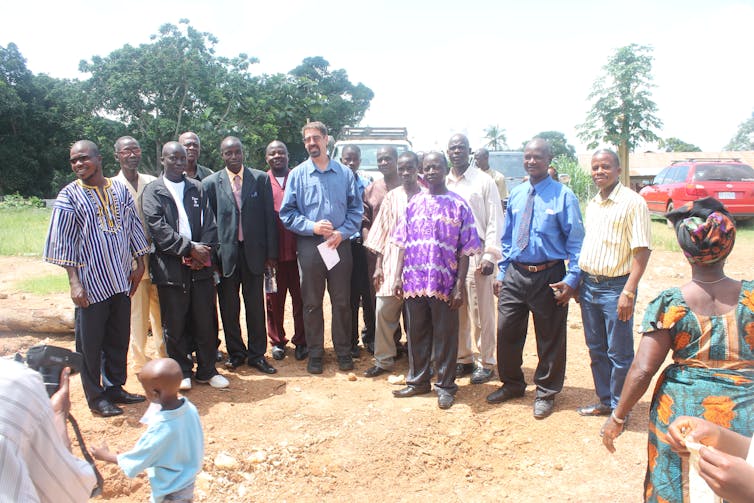![]()

Steven Hatch, University of Massachusetts Medical School
The 2018 Ebola outbreak in the Democratic Republic of Congo(DRC), has been a very different kind of outbreak than the massive West African outbreak that occurred in 2014 and 2015. For starters, it is much smaller, with just over 2,000 cases compared to the more than 28,000 cases of the West African outbreak. Because of that, many Western news organizations have devoted much less attention to the current epidemic.
Until this month, that is, when news of cases in Uganda led to proclamations of alarm throughout the world after three people were diagnosed, two of whom have died.
Should you worry for your own safety about the spread of cases into Uganda? No, you shouldn’t.
But should you be very concerned by the ongoing outbreak in the DRC? Yes, you should, because of political and cultural factors. As an infectious disease doctor, I cared for Liberian patients during the 2014-15 West African outbreak. Watching the current outbreak from afar, I have been thinking about the differences that make this outbreak arguably harder to stop. Understanding the differences – and similarities – between the previous outbreak and the current one can help tremendously.
At a biological level, the two outbreaks are identical: the virus (formally known as Ebola Zaire) is the same. It is rapacious, still killing about 70% of its victims. And as before, there remains no known, definitive cure for infection.
However, there have been positive developments: New drugs are being studied in organized trials in the current outbreak. And perhaps the most important factor of all is that a safe and effective vaccine has been deployed. A preliminary analysis of the vaccine in DRC indicates it has been more than 97% effective. These results strongly suggest the Ebola vaccine has saved hundreds, if not thousands, of lives.
These factors, along with an organized international response implemented more quickly than in the West African outbreak of 2014-2015, have resulted in a smaller number of cases, and, until recently, prevented international spread. But other circumstances have hindered efforts to contain the virus, and these have led, I believe, to the outbreak spreading into Uganda.
Unlike Liberia, Sierra Leone and Guinea – the three principal countries of the West African outbreak – the North Kivu and Ituri provinces of the DRC have been a war zone effectively for the past generation. The Kivu conflict alone includes armed groups representing the interests of multiple regional and European states. The fighting has led to millions of displaced people. To a great extent, an area the size of Alabama has spent more than 20 years in a state of lawlessness.
This instability, combined with the ongoing military conflict in the DRC, is an ideal environment for Ebola. As with many outbreaks, the misery of a given infection is defined as much by the structural inequalities brought on by war and poverty as it is by a microbe’s biological characteristics. International aid workers have been attacked by hostile groups, forcing medical groups to close down treatment units and curtail their vaccination programs. The consequence has been a rise in new infections, which may lead to a feedback loop in which more people become harder to treat, causing more infections in turn.
According to reports, militia groups are very likely involved in these attacks, but locals too may be involved, motivated by suspicion and fear. This happened at the height of the West African outbreak, when villagers attacked a group of health professionals trying to teach Ebola prevention techniques in rural Guinea, killing eight.
The good news is that attitudes toward the Ebola vaccine appear to be positive in the affected areas. The bad news is that there remains a significant percentage, maybe as high as 20% of people, who profoundly distrust the government, often because the government has acted as a “battlefield enemy”.
Further, a recent New England Journal of Medicine commentary by a doctor working in the region suggested that people who live in DRC are often skeptical of the intentions of international aid organizations who set up Ebola treatment units, yet seem to be unconcerned with tuberculosis and malaria, which are major and longstanding scourges in Africa. All these factors may cause families to “hide” Ebola cases from contact tracers, leading to further spread.
Thus, the vaccine keeps the current outbreak partially in check, while instability prevents its eradication. By contrast, the West African outbreak of 2014-2015 rose with such unprecedented speed that it dominated world headlines for nearly four months between August and October 2014. The alarm it generated led to the international response that helped contain it; today’s DRC outbreak has not resulted in the same alarm.
The longer Ebola persists in the DRC, the more likely an improbable event will occur – like the spread of the virus beyond the borders of the DRC, or perhaps much further beyond its borders. The spread into Uganda may simply be a warning sign. There is little cause for optimism that the epidemic will end anytime soon.
What both outbreaks do share is a devastating economic impact, one that can also spread beyond its borders and “infect” the entire region. The West African outbreak of 2014-2015 cost no less then several billion dollars, possibly as much as tens of billions of dollars. If Uganda becomes heavily involved, the current outbreak may prove equally costly.
[ You’re smart and curious about the world. So are The Conversation’s authors and editors. You can read us daily by subscribing to our newsletter. ]
Steven Hatch, Associate Professor of Medicine, University of Massachusetts Medical School
This article is republished from The Conversation under a Creative Commons license. Read the original article.
Comments